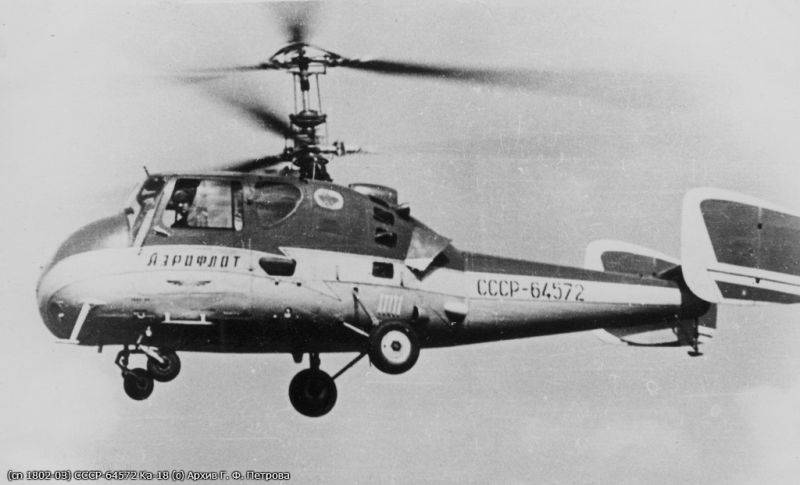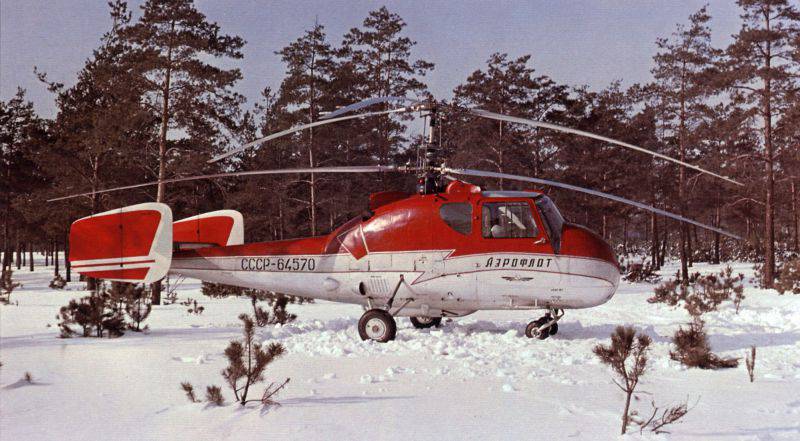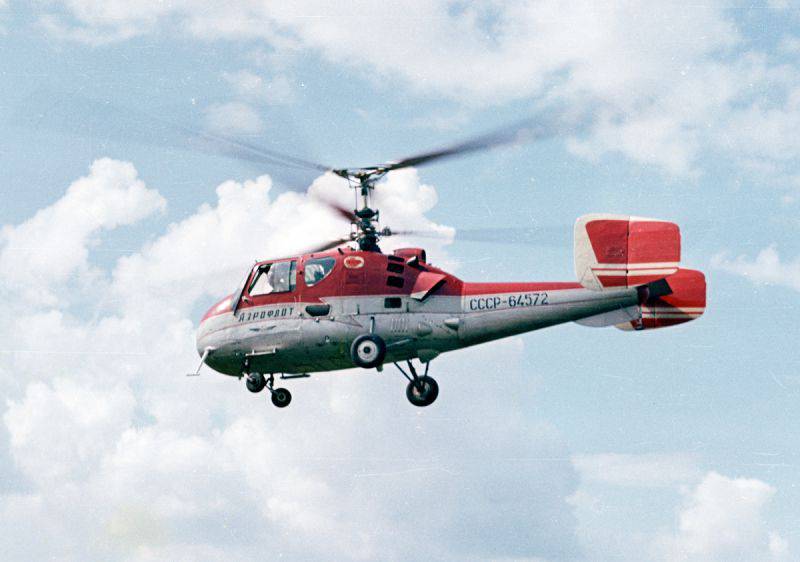Ka-18 multipurpose helicopter
The Ka-18 was designed for civilian operators. The list of works performed by this helicopter included the transportation of mail and cargo, passengers and patients. Together with the Ka-15 helicopter it was also used for aerial chemical works. An experimental prototype of the Ka-18 was built in the 1956 year. In 1957, the car successfully passed the state tests. The Ka-18 helicopter was mass-produced and was in operation for more than 15 years. A total of X-NUMX Ka-111 helicopters were assembled at the Ulan-Ude helicopter plant, and the total number of helicopters produced of all modifications was approximately 18 units.
For the first time, the Ka-18 multi-purpose helicopter, which is, in fact, a four-seat version of the Ka-15 helicopter, flew into the sky on October 13 1956. Compared with the base model, the tail boom and fuselage were extended in the new rotorcraft, as well as the number of tail washers was increased and the cabin was expanded. In addition to the pilot, in the cabin of the Ka-18 helicopter were equipped seats for 3-x passengers. It was also possible to transport one sick or wounded person on a stretcher with accompanying medical staff.
The use of the Ka-18 helicopter was envisaged in the following basic versions:
- passenger and cargo version of the helicopter (designed to transport people and goods, as well as mail and baggage inside the fuselage. This version was equipped with a heating system);
- patrol version of the helicopter (designed to patrol territories by law enforcement agencies);
- sanitary version of the helicopter (designed to transport sick and injured people. The structure of such a helicopter included an oxygen plant and a heating system).
In the sanitary version of the Ka-18 helicopter, a set of special (removable) equipment included: an oxygen installation, a stretcher, a trough, a thermos, and tie-down straps. For non-removable sanitary equipment could include a table of a medical worker and a helicopter first aid kit. In this case, the passenger version of the helicopter could easily be converted into a sanitary version by dismantling the front passenger seat and installing removable sanitary equipment instead.
In the USSR, for the Ka-1958 and Ka-1963 helicopters, special fiberglass propeller blades B-18 were made in the USSR (initially, the first models of the Ka-15 used wood blades). According to the developers, for their production had to use a new at the time of the baking system in autoclaves under the influence of the press. This type of production made it possible to get completely identical in size and weight parts, which was a significant step forward in the domestic helicopter industry. New fiberglass blades were strong, resistant to weather fluctuations, and also differed in speed of production. The use of fiberglass blades increased their resource and ensured the helicopter improved aerodynamic qualities of the rotors.
For flights in cold weather, especially in winter, the Ka-18 helicopter provided for a special heating system, the main elements of which were an electric heater, as well as pipelines for supplying heated air to the lower part of the passengers and pilot helicopter seats. Also, Soviet designers managed to significantly expand the geography of operation of the machine due to the introduction of an anti-icing alcohol system into the design of the helicopter. The purpose of the anti-icing system was to provide flight during icing of some elements of the structure. The essence of this system was to implement the principle of washing the cockpit glass, screw blades with a special anti-icing fluid that destroyed the ice and interfered with its further formation.
From the design point of view, the Ka-15 and Ka-18 helicopters were manufactured in a twin-screw coaxial design with a single piston engine and a four-bearing chassis. The truss fuselage had an aluminum alloy shell. In the fuselage of the helicopter there was a double crew cabin with adjacent pilot seats (on the left side) and an operator (on the right side), the cabin was distinguished by the presence of two sliding doors and a large glazing area. At the same time, the dimensions of the cabin were increased, which made it possible to place two more chairs intended for passengers or a patient on a stretcher. In front of the cabin there was a fairing to accommodate the necessary equipment.
The tail of the helicopter of a semi-monocoque design was made of aluminum alloy. A rectangular stabilizer with trapezoidal keel washers and rudders is attached to the beam from above. The Ka-18 chassis was four-axle, non-retractable. In this case, the front supports were equipped with self-orienting wheels, and there was a safety support on the tail boom. On the ship versions of the Ka-18, it was possible to use a float-type chassis.
The power plant of the helicopter consisted of an AI-14B engine, on top of which was a reduction gearbox and a distribution gearbox with a drive column of coaxial rotors, and the 2 fuel tank at the bottom. At the end of 1960, Ka-18 multi-purpose helicopters began to be equipped with forced engines, which received an AI-14WF index, and developed an 200 kW power. The control system of the helicopter was usual with cable wiring, the track control is provided by the deviation of the rudders and the differential pitch of rotors.
At the beginning of the 1970-s, the Ka-18 helicopters began to be actively replaced with a more advanced Ka-26 model, despite this many machines remained in operation until the middle of the 1970-s, and some longer. To this day, at least two copies of this helicopter have been preserved. One of the Ka-18 helicopters with the tail number USSR-68627 is on display at the aviation museum in Monino. The second helicopter with a tail number USSR-64659 is a training tool at the Irkutsk National Research Technical University (IRNITU).
Flight performance Ka-18:
Overall dimensions: length - 10 m, height - 3,4 m, diameter of the main screw - 10 m.
The maximum take-off weight of the helicopter is 1502 kg.
The power plant - 1 PD AI-14VF, power 200 kW.
The maximum flight speed is 160 km / h.
Cruising flight speed - 130 km / h.
Practical range - 450 km.
Practical ceiling - 3500 m.
Crew - 1 man.
Passenger payload - 2-3.
Information sources:
http://www.airwar.ru/enc/uh/ka18.html
http://www.aviastar.org/helicopters_rus/ka-18-r.html
http://www.uhlib.ru/transport_i_aviacija/krylja_sverhderzhavy/p182.php
http://avia.pro/blog/vertolet-ka-18



Information